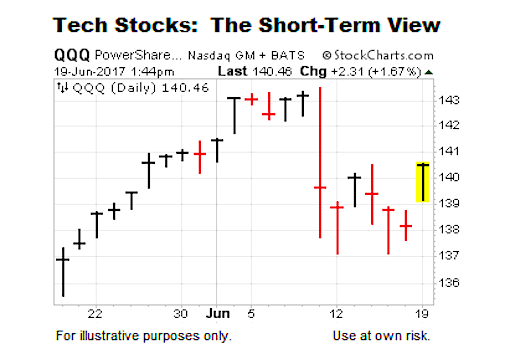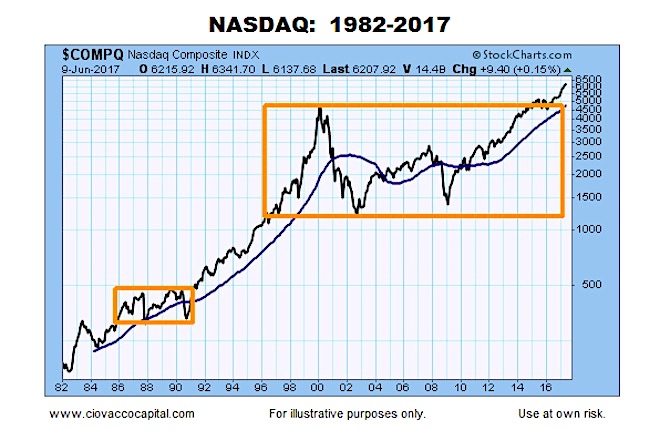We Tend To Make The Same Mistakes Over And Over
If you are perplexed by the post-election strength in U.S. stocks, it may be helpful to take a giant step back. From The Wall Street Journal:
Many of the financial mistakes people make are caused by a fundamental shortcoming: They can’t see the big picture. In behavioral economics circles, this is known as “narrow framing”—a tendency to see investments without considering the context of the overall portfolio. Many people are vulnerable to it.
Technology stocks provide an anecdotal example of narrow framing. As shown in the chart of the NASDAQ 100 ETF (NASDAQ:QQQ) below, the short-term view has been marked by unsettling volatility.
PowerShares Nasdaq 100 ETF (QQQ) Chart
However, if we look at the NASDAQ Composite (INDEXNASDAQ:.IXIC) from 60,000 feet, we see a much more encouraging picture. The narrow view says “tech stocks have gone up for years and may be in a bubble”. The longer-term view says, “the NASDAQ was able to make it back to the highs made in 2000, and recently broke out of a 20-year period of consolidation.”
The Three Most Important Questions For Investors
This week’s video looks at long-term economic and financial market evidence to address the question “does history support the notion that the world is on the brink or that things tend to gradually get better over time.” The video covers numerous charts to assist in combating the human tendency to focus on narrow timeframes.
Short-Term Focus Can Be Harmful
With smart phones and computers making balances, quotes, and P/L accessible 24-7, it is easy to fall into narrow framing mode. From The Wall Street Journal:
The easiest way to achieve your long-term goals, and avoid focusing on short-term losses, is to check your portfolio less often. While it’s now possible to get instant updates on the latest swings of the market, this additional information can lead to narrow framing. This is what the best investors do: They seek out the big picture. And then, once they’ve found it, they remember not to look at it too often.
What about earnings and valuations? Both are reasonable areas of concern. While the conclusions may surprise some, a review of historical facts on January 7, 2017 moved those concerns out of showstopper territory.
Get more investing research from Chris on his CCM website. Thanks for reading.
Twitter: @CiovaccoCapital
The author or his clients may hold positions in mentioned securities at the time of publication. Any opinions expressed herein are solely those of the author, and do not in any way represent the views or opinions of any other person or entity.










